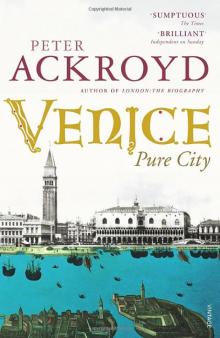- Home
- Peter Ackroyd
Venice Page 2
Venice Read online
Page 2
The port was no doubt used by those vessels sailing between Aquileia and Ravenna, bearing grain from Pannonia as well as goods and supplies from more distant shores. Amphorae have been discovered here, for the carriage of wine and olive oil that had come from the eastern Mediterranean. The larger ships would dock on the island, their goods then transported to smaller ships for the shallows of the lagoon. There must have been local pilots, therefore, to guide the craft through these exiguous waters. A walkway, dating to the second century AD, has been found beneath the nave of the basilica of S. Maria Assunta on the island of Torcello. Roman remains have been found at a great depth on the island of S. Giorgio Maggiore, and material from the first and second centuries has been discovered on smaller islands. Other finds, on other islands, can be dated from the fourth to the seventh centuries. It has been suggested that the outer islands of the lagoon could have been used as a station for the Roman fleet; it is conceivable, to say no more, that villas were constructed here.
Yet there was a fundamental change in the nature of the lagoon when the exiles from the mainland began to arrive in larger and larger numbers. There was no central exodus, but rather successive waves of migration that culminated in the late sixth century. The Veneti were escaping from invaders. In 403 Alaric the Visigoth descended upon the province of Venetia; in the words of Claudian, the historian of Rome, “fame proclaimed the march of the barbarian, and filled the land with terror.” Aquileia and Verona fell, with many of their inhabitants fleeing to the safety of the islands. When the threat of Alaric had passed, some returned home. But others stayed, making a new life in the lagoon. In 446 Attila gained Roman provinces from the Danube to the Balkans and then, six years later, took Aquileia; Altino and Padua were also sacked. Once more the refugees from these disasters fled to the lagoon.
There was a pattern to their movement. The people of Altino migrated to Torcello and Burano, for example, while those from Treviso went to Rialto and Malamocco. The inhabitants of Padua sailed to Chioggia. The citizens of Aquileia moved to Grado, which was itself protected by marshes. They came with craftsmen and builders, with farmers and labourers, with patricians and plebeians; they came with the sacred vessels from their churches, and even with the stones of their public buildings so that they might build anew. But how could they build on such shifting ground? How could they build upon mud and water? It was possible, however, for wooden poles of from ten to a dozen feet in length to be sunk into the mud before reaching a layer of harder clay and dense sand that acted as a firm foundation. This was the “boundary” at the bottom of the lagoon. So there sprang up small houses known as casoni made from the wood of poles and boards, with pitched roofs of wattle and reed.
New towns, such as Heraclea and Equilio (Jesolo), were founded by the edge of the lagoon. On the islands were established village communities, with leaders consulting assemblies of the people. The Veneti may also have set up fortified encampments, in the event that the Huns or Goths decided to move against them. But the islanders were fractious and competitive; there was no unity in the lagoons. So in 466, just twenty years after the appearance of Attila, a meeting of all the Veneti of the lagoon was held at Grado. It was decided that each island would be represented by a tribune, and that the tribunes would then work together for the common good. They were, after all, facing the same dangers and difficulties—not least from the depredations of the sea. This was the first sign of the public and communal spirit that would one day manifest itself so clearly in Venice itself.
The Veneti were by the sixth century a defined presence in the region. They were paid to ferry people and goods between the ports and harbours of the mainland. They transported the soldiers of Byzantium from Grado to the river Brenta. They carried officials and merchants to Byzantium itself. Already they were known for their maritime skills. Their boats travelled up the rivers of northern Italy, trading salt and fish to the cities and villages en route.
The first description of these island people comes in a letter sent in 523 to their tribunes by a legate from the Ostrogoth kingdom then prevailing in northern Italy. Cassiodorus was asking them to transport wine and oil across the waters to Ravenna. “For you live like seabirds,” he wrote, “with your homes dispersed, like the Cyclades, across the surface of the water. The solidity of the earth on which they rest is secured only by osier and wattle; yet you do not hesitate to oppose so frail a bulwark to the wildness of the sea.” He was not quite accurate in his description; there were already some houses constructed from the stone and brick of the mainland. He went on to say that the Veneti “have one great wealth—the fish which suffices for you all. Among you there is no difference between rich and poor; your food is the same, your houses are all alike.” Again, this was not quite true. Extant testimonials suggest that, even at an early stage in the development of the lagoon, there were rich as well as poor families. Cassiodorus then added that “your energies are spent on your salt fields; in them indeed lies your prosperity.” In this, at least, he was right. And he added the significant detail of “your boats—which like horses you keep tied up at the doors of your dwellings.” By good fortune one of these boats has emerged from the mud of the lagoon. Part of a rib of oak, and a hull of lime, have been found on the island of S. Francesco del Deserto; the boat itself dates to the fifth century. It was lying at a level that, in this period, would have been submerged except at times of low tide.
Yet Venice itself was not yet born. It is not shown in a fourth-century map of the region, in which the lagoon is depicted as a sea route without people. Venetian historians claimed, however, that the city was established at midday on 25 March 421, by a poor fisherman known as Giovanni Bono or John the Good. There are advantages to this theory, since the same date has been given to the vernal equinox, the Annunciation and the supposed date of the foundation of Rome. The triple coincidence, as well as the provident arrival of John the Good, is too good to be true; but it is part of the extraordinary Venetian ability to supplant history with myth. As the German poet, Rilke, said on a visit to the city in 1920, “as with mirrors one grasps nothing but is only drawn into the secret of its elusiveness. One is filled with images all day long, but could not substantiate a single one of them. Venice is a matter of faith.”
In fact Venice emerged over a century later, after a series of invasions by the Lombards in the late 560s and early 570s. Once more the province of Venetia was overcome by alien tribes. Unlike the Huns, however, they did not wish to plunder and depart. They intended to stay and to settle. They overran what is now called in their name the region of Lombardy. Their arrival prompted a mass exodus of the Veneti. The bishop of Aquileia moved his see to the edge of the lagoon at Grado. The bishop of Padua removed himself to Malamocco, and the bishop of Oderzo sailed to Heraclea. These men were secular as well as religious leaders; they took citizens as well as congregations, ready to create new communities on the water. Burano and Murano were extensively settled, as well as smaller islands such as Ammiana and Constanziaca; these last two disappeared beneath the waves in the thirteenth century, swallowed up by the main enemy of the island people. They have never rested in their battle against the sea.
Venice was born in this flight from the Lombards. The most recent archaeological investigations have dated the first signs of human habitation to the second half of the sixth century and to the seventh century; these remains were situated in the neighbourhood of Castello, in the east of the city, and beneath Saint Mark’s Square. There is evidence, too, that in these early years work had already begun on raising the surface of the land and reclaiming earth from water. The settlers fenced the soil with planks and poles; they drained the water; they laid down building rubble, or sediment, or sand from the dunes; they erected wooden palisades to resist the sea. It is the beginning of the city.
The exiles had decided to settle on a favoured group of islands, midway in the lagoon, known collectively as the Rivoalto or the high bank. This eventually became the Rialto, the pre-eminent market-place and emporium
of the city. The islands were interspersed with rivulets and water-courses but there was one larger river, a tributary of the Brenta known as the Rivoaltus; this became in time the Grand Canal. Two more solid hills or islands—their description depends entirely upon how you judge the nature of the territory—faced each other along the course of this river. This is where Venice was created. This was land where the exiles could build. It was not easy work. In 589 there are reports of catastrophic flooding throughout the entire region, the force of which was so great that the course of certain rivers was altered. The calamity would have changed the hydraulic structure of the lagoon, but its effects upon the emerging Venice are not known.
Venice did not immediately become the most important city of the lagoon. Grado was the seat of the patriarch; Torcello was the great emporium or market of the region. The ducal seat, as it became known, moved from Eraclea to Malamocco. In the period when Venice was first being settled, there were elaborate building works elsewhere. The basilica of S. Maria Assunta was then being built on Torcello; an inscription on that site is dated 639, and confirms that the church was erected within the context of Byzantine ritual and worship.
The connection with Byzantium is important. The historiographers of Venice insisted that from the beginning the Venetians asserted their independence. There is a famous legend of their leaders telling a representative from Byzantium that God Himself “has preserved us that we may live in these watery marshes, in our huts of wood and wattle. For this new Venice which we have raised in the lagoons has become a mighty habitation for us.” They could not be touched by the kings and princes of the world “unless they come by sea, where lies our strength.” This is pure myth-making. The Venetians were at the beginning a subject people. The language of the early Venetians had an admixture of Greek, for example, and as late as the last century there were still Graeco-Roman elements in the dialect of the islanders of Burano.
There is some disagreement about the date when the first military commander of the lagoon, or dux, was appointed by the Byzantines; it is most likely to have been in the early eighth century. The Venetians came to believe that he had been chosen by the island people themselves, but there is no doubt that this duke or doge reported to the emperor in Byzantium. The appointment of a military commander did not in itself bring any harmony to the lagoon; the early centuries were filled with internecine strife, between island and island or family and family; there are reports throughout the eighth century of civil war, of battles in the forests surrounding the lagoon, of doges being blinded or murdered or sent into exile. But the political institution survived the early crises; a doge reigned in Venice for more than a thousand years, 120 doges in unbroken succession.
Venice is made up of 117 separate islands that were with effort and labour eventually conjoined. There were at first scattered island parishes, some of them dominated by monastic foundations and others by small communities such as fishermen or salt producers. There would have been islands of boat-builders, too. These insular communities were grouped around a church and campanile or bell tower; the green or square in front of the church was (and is still) known as the campo or field. In the campo was a well or cistern of fresh water collected from the frequent rain. The houses were characteristically of reed and wattle construction, although the houses of the more prominent citizens may already have been constructed out of brick and tile. Some islands were dominated by powerful families, exiled from the mainland, who kept their retainers around them to cultivate their gardens or vineyards; the Orio and Gradenigo families, for example, controlled the island of S. Giovanni di Rialto. Each island had its own patron saint.
The island parishes were separated from each other by marsh or water, but waterways had been established to connect them. There was already a pattern of habitation that grew steadily more intensive and determined. The drive towards cohesion was advanced by another invader. In 810 Pepin, the son of Charlemagne, brought his forces to the lagoon in order to claim it for the Frankish Empire. He attempted to storm the ducal seat of Malamocco, and the doge fled to the islands of the Rivoalto for protection. It is said that Pepin followed in pursuit, but that his fleet became enmired in the marshes and receding waters; that he despatched rafts made of timber and brushwood, but that Venetian sailors destroyed them; and that an old woman directed them across the treacherous shallows with the old Venetian instruction, sempre diritto—just go on in the same direction. There are unmistakeable intimations here of the army of the pharaoh being overwhelmed by the Red Sea, an analogy upon which future Venetian painters would dwell. Whatever the true circumstances of the defeat, Pepin was forced to abandon his mission. So the place of ducal refuge, Venice, was proved to be the place of safety. It was inviolable, sheltered among the marshes. It was protected by the lidi from the sea, and separated from the mainland by water. After the invasion of the Franks, Venice became the ducal seat. It became the centre of the lagoon. It had begun its great career.
It prospered, too, from its secluded position. In a treaty of 814, it was agreed that Venice would remain a province under Byzantine rule but that it would also pay an annual tribute to the Frankish king whose seat was now in Italy. This may sound like a double obligation, but in fact it freed Venice from single domination. It now stood between Franks and Byzantines, between West and East, between Catholic and Orthodox; its central position allowed Venice to steer a somewhat uncertain course, sometimes leaning to one side and sometimes to the other. It also provoked many disagreements among the ruling families of the lagoon, which had different allegiances and loyalties among the parties of the mainland and of the Eastern Empire. Nevertheless the position of Venice effectively secured its independence. One of the clauses of the treaty of 814 allowed Venetian merchant ships to sail freely to and from Italian ports. The Venetians, in other words, were able to trade. They could move between East and West. Venice became, predominantly, a city of merchants.
And it grew very rapidly. Many of the inhabitants of the lagoon soon migrated to the small islands around the Rivoalto. By the end of the ninth century there were some thirty island parishes, and by the close of the millennium there were more than fifty; the effects of a fire in 976, when three hundred houses were destroyed, is a testimony to the dense population. Those parishes grouped closest to the Rivoalto became connected by bridges or canals. The ramparts were erected, the marshes drained, the dykes constructed; the swamps were reclaimed, and the ground made fertile. Some of the major streets, surviving still, were then first laid out as footpaths. Stages and landing stairs were built, some public and some private. Dams were created to prevent the silt from the rivers washing into the lagoon. A service of ferry boats was instituted. Venice became an urban mass, hot and energetic, fixed upon the mud and water. It represented a vast human and communal effort, urged on by necessity and practicality. The goal of common existence was always there. There was a desire to make or to reclaim land, to conquer the water, to unify and to protect the common soil.
Venice in the ninth and tenth centuries was a medieval city, where pigs roamed about the streets and where pastures and gardens interrupted the vista of houses and churches. There were districts with the epithet “In the Marsh” or “In the Wilderness” or “In the Seaweed.” The citizens travelled on horseback along the main street, the Merceria, and tethered their animals to the great elder trees which flourished in what is now the Piazza S. Marco or Saint Mark’s Square (otherwise simply known as the Piazza). There were flat wooden bridges, without steps, connecting the islands. There were trees along the banks of the canals. On the surrounding islands there were meadows where cattle and sheep grazed; there were vineyards and orchards; there were ponds and small lakes. On the central islands, which gradually coalesced, there were courtyards and narrow alleys that bequeathed to the calli of modern Venice their unique circuitry. In front of the houses of stone, or even of the poorer houses of wood and reeds, were short stretches of land; these became the fondamenta of the mature city, the streets
running along the canals.
By the end of the first quarter of the ninth century the area around what is now Saint Mark’s Square had been completed. There was a ducal palace or castle here, together with a large ducal chapel dedicated to the Byzantine Saint Theodore. The more important families also built residences here, to be close to the centre of power. Eventually the fields were cleared to make way for a piazza; a large pool or fishing-pond was filled in, thus forming the piazzetta or little piazza in front of the ducal palace. This duopoly of sacred and secular authority held its place on the site for more than a thousand years.
It was not called Venezia until the thirteenth century. But the region of the lagoon was known as Veneto or Venetia. The Latin term for Venice was always Venetiae, thus registering its origin as a federation of islands or cities. It has nineteen different appellations, ranging from Venegia to Veniexia, thus affirming its multiple identity. It might be construed a portmanteau word, containing Venus and ice.
Venice had no single or distinct origin. The cities of the Italian mainland had been settled through prehistory, their territory defined by their burial grounds and defended by a circumambient wall. They had grown in organic fashion from a ritual centre to an expanding periphery. The reverence for the city is linked to the reverence for place and reverence for the dead who lie interred there. The earliest cities are primeval in origin. From the beginning Venice had no perimeter. It had no outline. It coalesced from a hundred different points. Venice, in a literal sense, had no roots. It had a fluid origin indeed, one written in water. It is insecurely placed in the world. That is why it has always been subject to anxiety, as in the present “Venice in Peril” campaign.
Venice has therefore sought to define itself. It has sought for origins. It has felt obliged to uncover some hidden, or reveal some absent, origin. Machiavelli wrote that “the beginnings of religions and of republics and of kingdoms must possess some goodness by means of which they gain their first reputation and their first growth.” This was the problem facing the Venetians. They had, in that sense, no “goodness.”

 The Clerkenwell Tales
The Clerkenwell Tales The Canterbury Tales
The Canterbury Tales J. M. W. Turner
J. M. W. Turner Chatterton
Chatterton The Canterbury Tales – A Retelling
The Canterbury Tales – A Retelling Alfred Hitchcock
Alfred Hitchcock Three Brothers
Three Brothers Wilkie Collins
Wilkie Collins Venice
Venice Poe
Poe The Lambs of London
The Lambs of London London
London Queer City
Queer City Revolution, a History of England, Volume 4
Revolution, a History of England, Volume 4 Venice: Pure City
Venice: Pure City Foundation
Foundation Thames
Thames The Plato Papers
The Plato Papers The house of Doctor Dee
The house of Doctor Dee Rebellion: The History of England from James I to the Glorious Revolution
Rebellion: The History of England from James I to the Glorious Revolution Albion: The Origins of the English Imagination
Albion: The Origins of the English Imagination The Fall of Troy
The Fall of Troy The Death of King Arthur
The Death of King Arthur The Trial of Elizabeth Cree
The Trial of Elizabeth Cree London: The Biography
London: The Biography The Casebook of Victor Frankenstein
The Casebook of Victor Frankenstein Hawksmoor
Hawksmoor Charlie Chaplin
Charlie Chaplin London Under
London Under